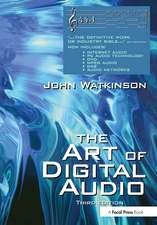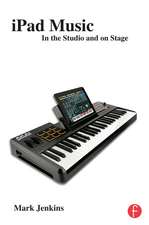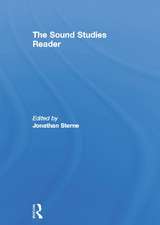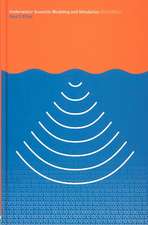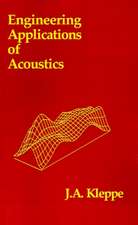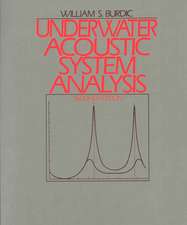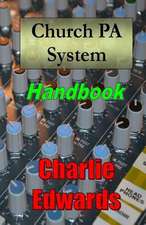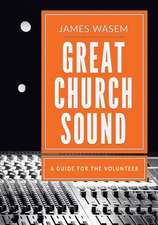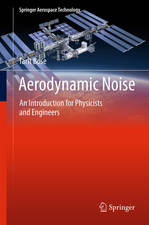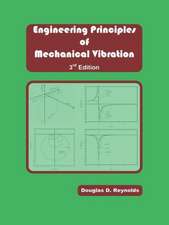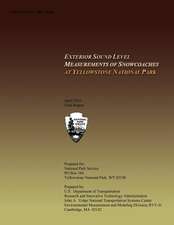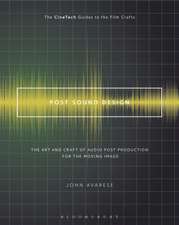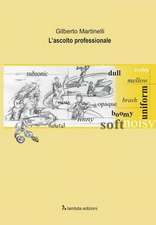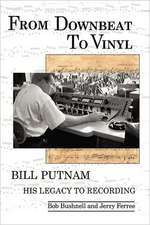Between Air and Electricity: Microphones and Loudspeakers as Musical Instruments
Autor Dr. Cathy van Ecken Limba Engleză Paperback – 5 sep 2018
| Toate formatele și edițiile | Preț | Express |
|---|---|---|
| Paperback (1) | 236.37 lei 6-8 săpt. | |
| Bloomsbury Publishing – 5 sep 2018 | 236.37 lei 6-8 săpt. | |
| Hardback (1) | 831.03 lei 6-8 săpt. | |
| Bloomsbury Publishing – 8 feb 2017 | 831.03 lei 6-8 săpt. |
Preț: 236.37 lei
Preț vechi: 305.04 lei
-23% Nou
Puncte Express: 355
Preț estimativ în valută:
45.23€ • 46.96$ • 37.72£
45.23€ • 46.96$ • 37.72£
Carte tipărită la comandă
Livrare economică 22 martie-05 aprilie
Preluare comenzi: 021 569.72.76
Specificații
ISBN-13: 9781501344718
ISBN-10: 1501344714
Pagini: 216
Dimensiuni: 152 x 229 x 16 mm
Greutate: 0.3 kg
Ediția:NIPPOD
Editura: Bloomsbury Publishing
Colecția Bloomsbury Academic
Locul publicării:New York, United States
ISBN-10: 1501344714
Pagini: 216
Dimensiuni: 152 x 229 x 16 mm
Greutate: 0.3 kg
Ediția:NIPPOD
Editura: Bloomsbury Publishing
Colecția Bloomsbury Academic
Locul publicării:New York, United States
Caracteristici
The first book to offer an overview of the history of electronic amplification in a cultural context
Notă biografică
Cathy van Eck is a composer, sound artist, and researcher in the arts with an interest in relationships between everyday objects, human performers, and electronic sound. She holds a Ph.D. of Leiden University and is lecturer at the University of the Arts in Bern.
Cuprins
AcknowledgementsIntroduction1 Beyond the curtain: the "true nature" of microphones and loudspeakersAn empty stage: listening according to the KonzertreformA concert at home: the invention of sound reproduction technologiesStorage of air pressure wavesTransportation of air pressure wavesAmplification of air pressure wavesBetween air and electricity A standard, almost perfect amplifier and loudspeakerMicrophones and loudspeakers: the musical instruments of our age?The "true nature" of microphones and loudspeakers2 reproducing - supporting - generating - interacting: four approaches towards microphones and loudspeakersMade for music: concepts on musical instrumentsViolins, mixing desks and spoonsPiano lessons or a phonograph: how sound reproduction technologies entered the living roomThe instrumental phonograph and the reproducing radioSemantic acts of sound creationHearing voices through the noise: completely satisfactory recordings in 1902Electricity, bodies and diaphragmsReproducing: one sound system for all musicSupporting: the same sound but louderTransparent technologyThe record as a copy of the concert and the concert as a copy of the recordGenerating: music without musical instrumentsInteracting: resonance and resistance3 The sound of microphones and loudspeakersAcoustic feedback: an electro-mechanical oscillatorThe tuning fork: an early sine wave generatorTransforming sound into a researchable objectHermann von Helmholtz: tuning fork experimentsHermann von Helmholtz: tuning forks reproduce human vowelsThe tympanic principle and the tuning fork principleAlexander Bell: metal rods reproduce soundAlexander Bell: metal plates reproduce soundRichard Eisenmann: an electric piano with tuning forksGeorge Dieckmann: a piano string oscillatorBechstein-Siemens-Nernst-piano: piano, radio and gramophone through the same loudspeaker 4 movement, material and space: interacting with microphones and loudspeakersAcoustic feedback: from mistake to musicMOVEMENTQuintet by Hugh Davies: changing the distance between microphone and loudspeakerPendulum Music by Steve Reich: introducing silenceBird and Person Dyning by Alvin Lucier: listening as a performative actGreen Piece by Anne Wellmer: interacting with another sound sourceMikrophonie I by Karlheinz Stockhausen: amplification onlySpeaker Swinging by Gordon Monahan and Three Short Stories and an Apotheosis by Annea Lockwood: moving loudspeakersMATERIALcoffee making by Valerian Maly and 0'00'' by John Cage: everyday actions amplifiedInside Piano by Andrea Neumann: musical instruments and contact microphonesApple Box Double by Pauline Oliveros and Shozyg by Hugh Davies: new instruments through amplificationNodalings by Nicolas Collins: acoustic feedback through objectsRainforest by David Tudor: every loudspeaker a different voiceAptium by Lynn Pook, and Merzbow: the audible becomes feelableSPACEMusic for piano with amplified sonorous vessels by Alvin Lucier: interaction between microphones and small spacesLoudspeakers in brass instruments and focused loudspeakers: interaction between loudspeakers and small spaces ...sofferte onde serene. and Guai ai gelidi mostri by Luigi Nono: interaction between loudspeakers and performance spaceAcousmonium by François Bayle: loudspeaker orchestrasPerformances by Eliane Radigue and Der tönende See by Kirsten Reese: sound unified in space and dispersed in spaceAudible EcoSystemics by Agostino Di Scipio: closing the acoustic feedback loop again5 Composing with microphones and loudspeakersBeyond musical instruments: a hybrid of approachesThe Edison tone tests: no differenceNothing Is Real (Strawberry Fields Forever) by Alvin Lucier: a piano in a teapotWindy Gong by Ute Wassermann: singing through the gongsnare drum pieces by Wolfgang Heiniger: invisible beatingtubes by Paul Craenen: musicians, dancers and techniciansOpen Air Bach by Lara Stanic: speeding up a sonataResistances and resonances of microphones and loudspeakersThe future of microphones and loudspeakers: between air and electricityAppendixBiographiesBibliography
Recenzii
This is a genuinely fascinating and under-represented area of compositional research and activity, and the strongest portion of van Eck's book is the riveting overview of the repertoire.
There is much to like about Between Air and Electricity ... An interesting feature of the book is a website ... There are a lot of examples and new text on the website, and one could spend numerous hours there alone.
The book was a combination of amazingly thoughtful critiques of pieces and techniques ... with new pieces and new ways of looking at (or listening to) equipment ... Anyone who is working in the area of sound art, interactive electronic composition or sound studies needs to read this book ... Van Eck brings a mature approach to the study of electronically produced sound, and I see a myriad of future scholarship written using the concepts and ontologies she developed for this book.
One of the most informative aspects of this book is its citation, and discussion of, documents and patents published many decades ago ... A succinct, well-researched text.
The subjects of this book, microphones and loudspeakers, are observed from an interesting and unusual perspective ... The opportunity for the author to exchange ideas with many different artists ... makes this research extremely lively and rich.
It is obvious that the influence of technology is a key issue in the study of music. Van Eck goes one step further: she explores the conscious use of speakers and microphones themselves as instruments ... An ambitious book.
Van Eck offers a captivating history of the development of loudspeakers and microphones and their fundamental influence on music practice-and the world beyond. In addition she covers an exciting collection of music, which she uses to analyse their fluid identity as a composing method and a musical instrument.
The large number of female composers represented here is noteworthy - it seems as though the allegedly male-dominated field of electronic music is just as much in the hands of women. (Bloomsbury translation)
The book is worth reading and aimed in particular at an audience without technical expertise ... A particularly informative addition is the accompanying website (www.microphonesandloudspeakers.com), where you can find not only audio and video documents discussed in the book but also numerous examples of other relevant works ... This book's originality lies in its dedication to these unconventional interactions with technology.
Cathy van Eck takes us on a wondrous journey from pressure waves to electric currents and reveals behind the curtain of technology historical narratives, cultural ideologies and artistic imaginings that bring its norms and capabilities into a new light. Her book draws out insightful connections between standards and possibilities, and permits the timely questioning of technological determinism and instrumental inevitability.
Between Air and Electricity fills a long standing niche. The text sets itself apart from the many technical books on microphones and loudspeakers, as Cathy van Eck gives refreshing and well-articulated insight into the artistic potential of working with these mediums.
In the hands of creative sound artists and composers, microphones and loudspeakers have challenged and changed our traditional definition of the musical instrument as well as the relationship of performance gesture to sound. Cathy van Eck's groundbreaking book systematically explores these alternative and radical new uses, finding four key approaches - 'reproducing - supporting - generating - interacting' - to help us navigate. Using a wide range of practical examples she shows how musicians and sound artists have explored this new found land which lies Between Air and Electricity. This book will be essential reading for practitioners and writers in music and media arts, as well as anyone interested in how things work in experimental art and music made with technology.
There is much to like about Between Air and Electricity ... An interesting feature of the book is a website ... There are a lot of examples and new text on the website, and one could spend numerous hours there alone.
The book was a combination of amazingly thoughtful critiques of pieces and techniques ... with new pieces and new ways of looking at (or listening to) equipment ... Anyone who is working in the area of sound art, interactive electronic composition or sound studies needs to read this book ... Van Eck brings a mature approach to the study of electronically produced sound, and I see a myriad of future scholarship written using the concepts and ontologies she developed for this book.
One of the most informative aspects of this book is its citation, and discussion of, documents and patents published many decades ago ... A succinct, well-researched text.
The subjects of this book, microphones and loudspeakers, are observed from an interesting and unusual perspective ... The opportunity for the author to exchange ideas with many different artists ... makes this research extremely lively and rich.
It is obvious that the influence of technology is a key issue in the study of music. Van Eck goes one step further: she explores the conscious use of speakers and microphones themselves as instruments ... An ambitious book.
Van Eck offers a captivating history of the development of loudspeakers and microphones and their fundamental influence on music practice-and the world beyond. In addition she covers an exciting collection of music, which she uses to analyse their fluid identity as a composing method and a musical instrument.
The large number of female composers represented here is noteworthy - it seems as though the allegedly male-dominated field of electronic music is just as much in the hands of women. (Bloomsbury translation)
The book is worth reading and aimed in particular at an audience without technical expertise ... A particularly informative addition is the accompanying website (www.microphonesandloudspeakers.com), where you can find not only audio and video documents discussed in the book but also numerous examples of other relevant works ... This book's originality lies in its dedication to these unconventional interactions with technology.
Cathy van Eck takes us on a wondrous journey from pressure waves to electric currents and reveals behind the curtain of technology historical narratives, cultural ideologies and artistic imaginings that bring its norms and capabilities into a new light. Her book draws out insightful connections between standards and possibilities, and permits the timely questioning of technological determinism and instrumental inevitability.
Between Air and Electricity fills a long standing niche. The text sets itself apart from the many technical books on microphones and loudspeakers, as Cathy van Eck gives refreshing and well-articulated insight into the artistic potential of working with these mediums.
In the hands of creative sound artists and composers, microphones and loudspeakers have challenged and changed our traditional definition of the musical instrument as well as the relationship of performance gesture to sound. Cathy van Eck's groundbreaking book systematically explores these alternative and radical new uses, finding four key approaches - 'reproducing - supporting - generating - interacting' - to help us navigate. Using a wide range of practical examples she shows how musicians and sound artists have explored this new found land which lies Between Air and Electricity. This book will be essential reading for practitioners and writers in music and media arts, as well as anyone interested in how things work in experimental art and music made with technology.


